Varjo XR-3 (Focal Edition) review: High-end XR has its price
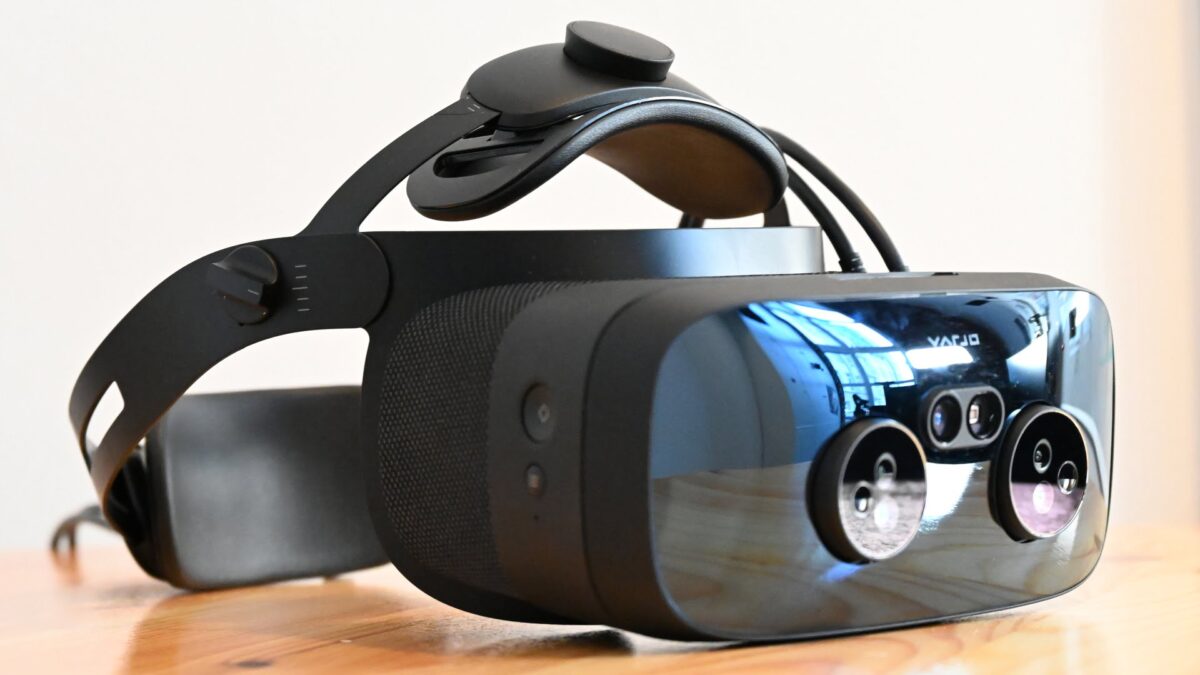
The professional VR headset Varjo XR-3 shows what near-perfect VR and AR looks like - and why it's still a long way from coming to the living room.
The dream of photorealistic, everyday virtual reality and augmented reality brings us all together here. The technology has made enormous progress recently, as shown for example by Metas Quest Pro.
While Meta offers a standalone XR solution for professional use with the Quest Pro, Finnish XR company Varjo focuses on wired high-end XR headsets. For use at home, Varjo released the Varjo Aero at the beginning of 2022. With its sharp image and high comfort, it is a great choice for VR sim gamers with some money in their pockets.
The Aero is a pure VR headset. However, the current trend is towards Mixed Reality. For this, Varjo offers the XR-3, and since a few days also in an improved version, the XR-3 Focal Edition. Varjo sent me their new flagship, which I tested extensively.
Configuration PC: Ryzen 9 3900X, RTX 3080, 64 GB RAM, Windows 10: The Varjo XR-3 (Focal Edition) was tested at the default setting of 27 PPD (35 would have been possible) to ensure a smooth test experience.
Note: Varjo XR-3 (Focal Edition) and Varjo XR-3 are identical except for the camera system.
Content
Varjo XR-3 (Focal Edition) review in a nutshell
Varjo XR-3 (Focal Edition) is a heavy but comfortable XR headset for specialized applications such as research, design, and high-end training. It requires in-house development capacity for software and customization.
The XR headset impresses with perfect image sharpness due to the double display design - this primarily applies to the VR image, but under good lighting conditions the passthrough is also almost perfect.
The new Focal Edition camera system offers even better depth perception and image sharpness at close range (30-80 cm). Here I lack a direct comparison to the XR-3, but in my opinion, the MR image is almost perfect.
A lot depends on the light: if the lighting is not good, I see image artifacts and sometimes strong ISO grain. Direct exposure to light also affects the image. Furthermore, the image often takes a moment to focus. Expect short blurs during movements as well as during the transition between the focus screen and the peripheral display.
The Varjo XR-3 is rather user-unfriendly since instead of its own UI, it is only operated via the desktop - either in the VR headset or via passthrough. The latter works flawlessly. Ultraleap hand tracking is good, and you can use VR controllers from HTC or Valve. The experimental standalone camera tracking did not convince me.
Varjo XR-3 (Focal Edition) is suitable for you if you …
- want perfect image sharpness in VR and passthrough (AR),
- want high wearing comfort,
- want to use perfect SteamVR tracking,
- want to run specific professional applications in simulation, design, research, and training
- can handle occasional display and software problems
- and own a high-performance computer.
Varjo XR-3 (Focal Edition) is less suitable for you if you …
- you want to use the headset as a private user,
- need a standalone VR headset,
- don't want cables and extensive connection management,
- do not own a high-end PC,
- expect fully developed, perfect image behavior,
- want user-friendly software and
- don't want to spend four to five figures for XR hardware plus SteamVR base stations and VR controllers.
Setup, configuration, tracking
The Varjo XR-3 (Focal Edition)'s dual USB-C cable lead to two headset adapter boxes (similar to the adapter box on the Vive headsets), each of which needs to plug into power. One DisplayPort port and one USB-A 3.X port each lead from both adapters to the computer.
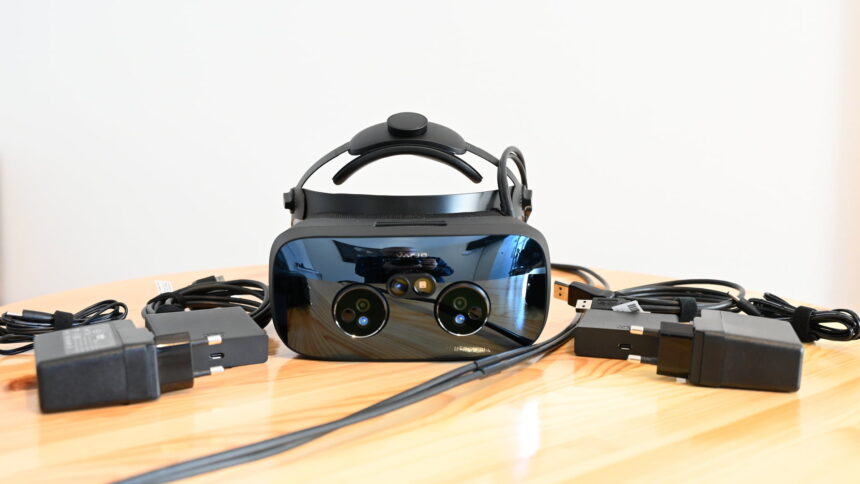
High-end XR needs cables, boxes, two DisplayPort ports and a strong computer. | Image: MIXED
Setup requires the Varjo Base software on PC and, in case of commercially licensed devices, a valid subscription (except for the offline version, see the privacy paragraph later in this article). As with Varjo Aero, I am guided through the configuration step by step. It's done after a few minutes, as I initially forgo SteamVR as a tracking option and try out the standalone camera tracking. I can switch to SteamVR tracking in the software at any time, and it works flawlessly.
The standalone tracking of the XR-3 (Focal Edition), which is currently in beta, is very sensitive to light. With normal room lighting, it stops tracking occasionally for a moment. The included tracking pattern that I can place on the floor for better camera orientation doesn't help a lot. I quickly switched back to SteamVR tracking because it works perfectly as usual.
The base stations for SteamVR tracking are not included in the package and have to be purchased additionally.
Varjo XR-3 (Focal Edition): Resolution, colors, refresh rate, screen-door effect
According to Varjo, the dual-display design delivers image sharpness with human-eye resolution. At least for the focal display, that should be true: In a focus area of 27 x 27 degrees, the uOLED display achieves a pixel density of 70 PPD with a resolution of 1,920 x 1,920 pixels per eye.
The peripheral display of the XR-3 (Focal Edition) offers an LC display with still 30 PPD at a resolution of 2,880 x 2,720 pixels per eye (compare: Varjo Aero; PPD of other VR headsets: Vive Pro 2 = 20; Valve Index = 11).
Now, differences in image sharpness are often perceived differently individually and are not always perceptible for everyone. However, the image sharpness of the XR-3 (Focal Edition) is already extraordinary at a default setting of 27 PPD (35 are possible, but don't work well on my system).
Even at the highest settings in Half-Life: Alyx, I can clearly see where Valve has worked carefully and where compromises have been made in terms of textures and objects. From a distance, I recognize larger texture areas as flat and sometimes terribly blurry, while the smallest details of the Gravity Gloves look as if they came straight from the 3D printer.
The colors are excellent and rich, and the representation of my real surroundings by the two 12-megapixel RGB cameras is fully realistic as well - if the lighting is right. This is true depth correct color passthrough, not a color overlay like the Quest Pro has. The whole thing runs at a smooth 90 Hz and the screen-door effect is not visible.
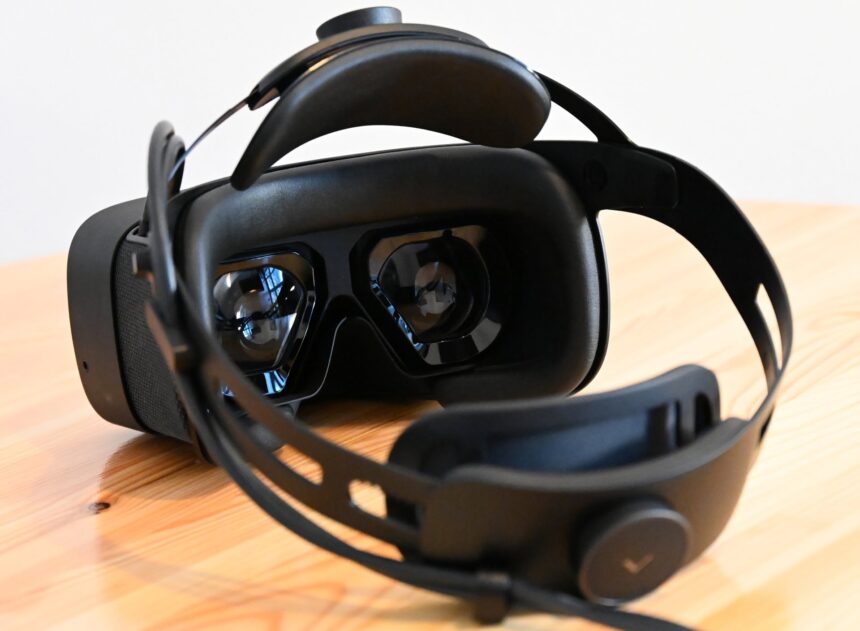
The double display construction delivers image sharpness with human-eye resolution - but it's not without problems. | Image: MIXED
However, the dual display construction has other issues. For example, I see differences in brightness and can distinguish the slightly darker focus area from the peripheral display when in motion.
The change between the two displays is also evident in the image's sharpness, which takes a moment to calibrate: If I move my head, for example when looking at the instruments of an airplane cockpit, it takes a moment to focus again. This also happens during the transition between focus and peripheral display.
The image curvature that appeared in my test of the Varjo Aero is not noticeable here. Still, the impression remains that the image is not always perfectly stable and sometimes seems to move slightly, which could cause motion sickness in some cases. In one case, the viewing axis suddenly changed in an AR demo and the view reversed, which immediately caused imbalance. Latency doesn't seem perfect either; occasionally I notice a latent lag.
With a stable sitting position and little or slow head movement, these issues are less noticeable, if at all.
Field of view, sweet spot, eye relief, eye tracking
The field of view of 115 degrees is good PC VR standard. As with the Varjo Aero, the flattened lenses at the top and bottom do not affect the good overall image impression. The sweet spot is huge, and the image sharpness towards the edges is excellent. There is a slight distortion at the very edge, but I only notice it when I focus on the edge while moving.
The interpupillary distance is automatically measured and adjusted via eye tracking: A motor moves the lenses into the right position. The fact that I wear glasses does not bother the system. Speaking of which, my glasses fit into the headset without any problems.
Controlling the software with my eyes works great. My gaze is tracked accurately and the information I look at is rendered sharply. I used the same demo as in the Aero test.
Passthrough & AR (Mixed Reality)
After the intriguing but somewhat immature mixed reality experience with the Quest Pro, I was eager to see high-end passthrough AR. The Varjo XR-3 (Focal Edition) does not disappoint.
The depth rendering seems just right, and I can move around my room, interact with objects, or work on my PC naturally. The on-screen displays are sharp and clear - developers will be pleased because they no longer have to constantly put down the headset to make adjustments or write lines of code.
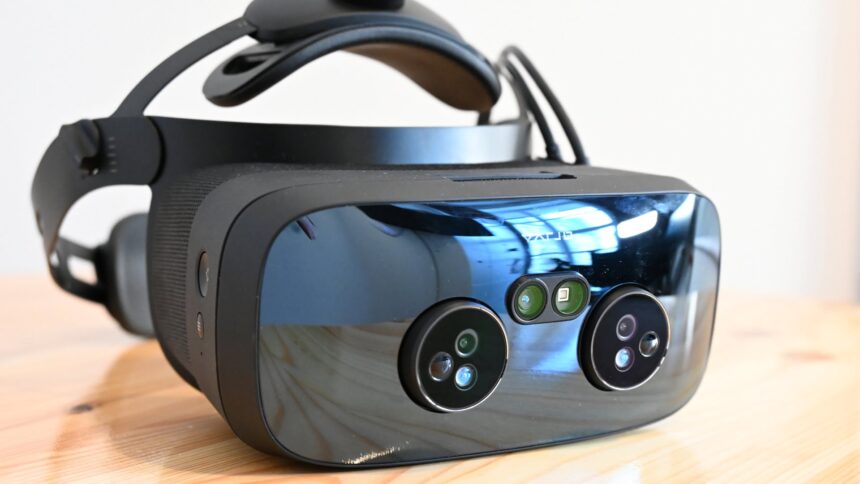
The new, expensive camera system of the Varjo XR-3 Focal Edition enables particularly sharp XR passthrough at close range. | Image: MIXED
The passthrough sharpness depends on good lighting. In normal room light, everything looks significantly darker and sometimes exhibits ISO grain. Light sources also interfere with the cameras.
Furthermore, I notice a delay when the displays adjust their focus: For example, if I look at my whiteboard, which has a letter on it, it takes a moment for the text to be sharp - but then I can see it clearly within arm's length. This is where the new cameras seem to make a difference, based on comparisons to the XR-3. I did not have the opportunity to compare them myself.
The display quality for 3D objects is fantastic: The (scalable) Volvo sedan looks deceptively real, the airplane cockpit that I enter through a virtual safety gate in my study is incredibly detailed and sharp.
I was particularly impressed with the display of a male skeleton, to which I can add or remove organs, circulation, muscles, and skin. The life-size skeleton in my room is so detailed that, as someone who hated biology in school, I would have loved to jump right into anatomy. For research and teaching, the image and object sharpness while still being able to see the real environment is definitely a plus.
But training, e.g. for pilots, is also taken to the next level with the XR-3 Focal Edition, when the real instruments are seen correctly via passthrough, while the outside world appears almost photo-realistic in VR.
Varjo XR-3 (Focal Edition): Wearing comfort
The head mount is the same as the Varjo Aero. Read the details in the linked review.
The Varjo XR-3 (Focal Edition) adds a good kilogram of weight to the head (which strains the neck over a longer period of time), but is otherwise very comfortable thanks to the clever adjustable mount over the forehead.
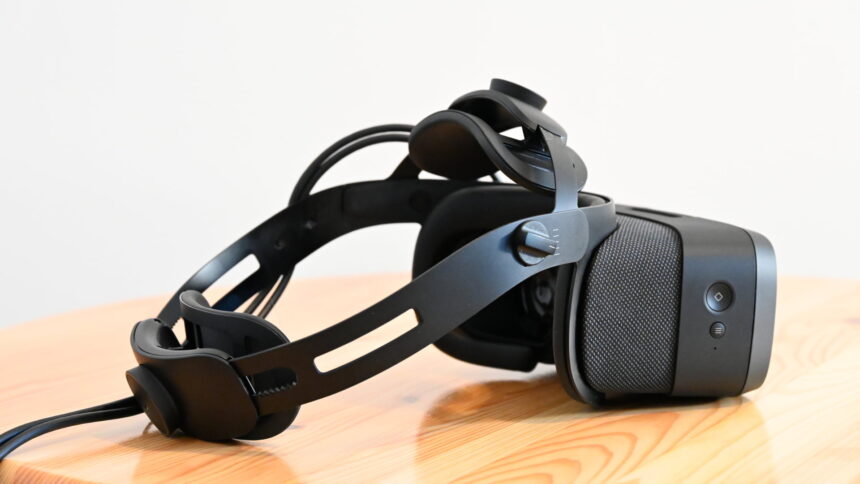
This XR headset weighs about two pounds - yet is one of the most comfortable headsets on the market. | Image: MIXED
Hand tracking and VR controller
Hand tracking comes from Ultraleap (Gemini v5) and worked well in the few cases where it was applicable. However, in the anatomy demo, it surprisingly had trouble detecting an outstretched finger of my hand at arm's length. Lighting could play a role here. Up close, however, it is accurate when I move my fingers, and Varjo menu operation also works well.
Varjo XR-3 (Focal Edition) supports SteamVR controllers from HTC or Valve Index. As usual, the tracking is excellent. You have to purchase VR controllers additionally.
Varjo XR-3 (Focal Edition) Sound and Software
Sound comes via headphones, there are no built-in speakers.
It gets interesting when it comes to the software - here it becomes apparent that the headset is only intended for professional users. Users usually have to create or at least customize applications for the headset themselves. The menu in the VR headset consists of a start button, a button for passthrough, eye-tracking calibration and the option to reset the position. That's about it.
When I start an application (directly on the PC), I can only close it via the escape key on the keyboard. I can stream the desktop to the XR headset, but using the software with controllers is not trivial.
On the other side, I can launch any software simply from a folder on my PC while wearing the headset - thanks to the crisp XR passthrough.
Varjo XR-3 (Focal Edition): Privacy
Varjo offers its VR-3 and XR-3 (Focal Edition) headsets with a mandatory account and a subscription for support, among other features. The privacy policy is quite strict compared to companies like Meta or Pico Interactive, especially when it comes to sharing personal data. For example, the transfer of data to third parties for their purposes is excluded.
Moreover, you can purchase an offline perpetual license. This means that no account and no connection to the Internet is required. Companies can then use the VR headset within a local network without running the risk of the device sharing data online. This also makes the Varjo XR-3 (Focal Edition) interesting for sensitive areas such as the military or healthcare.
Varjo XR-3 (Focal Edition) review summary: Perfect image quality that still needs software fine-tuning
There is no doubt that the image quality of the Varjo XR-3 (Focal Edition) is currently unrivaled in both Virtual Reality and Passthrough AR. If you primarily want image sharpness for highly specialized use cases, you can't go past Varjo.
However, even this expensive device (price on request, it's above the circa 7,730 Euros for the standard XR-3) does not deliver a fully mature mixed reality experience. Image distortions due to poor lighting, latencies, occasional distortions and errors in the image stability show that there is still much need for optimization.
I tested the Varjo XR-3 (Focal Edition) in the typical environment of a home user. Nevertheless, factors like user-friendliness are also important in the B2B sector. Being able to easily close software within VR should be possible. However, Varjo's focus is on the hardware with an external operator.
For VR enthusiasts at home, Varjo's latest headset shows that we are still in an innovation niche where it will be a long time before similar image quality combined with excellent usability reaches our living rooms. Zuckerberg was not exaggerating when he said that this path will take until the 2030s - perhaps even longer.
On the other hand, it's great to see what real high-end XR can do. Who would have thought that with the right XR headset, Half-Life: Alyx could look at least partially bad?
Varjo XR-3 and XR-3 Focal Edition: Datasheet
Note: Links to online stores in articles can be so-called affiliate links. If you buy through this link, MIXED receives a commission from the provider. For you the price does not change.